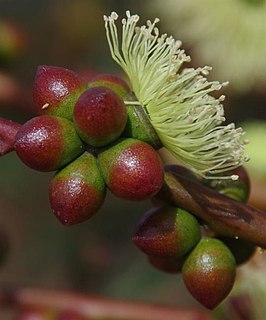
Eucalyptus fraseri, commonly known as Balladonia gum, is a species of tree or mallet that is endemic to Western Australia. It has smooth white to greyish bark, lance-shaped or curved adult leaves, flower buds in groups of seven or nine, white flowers and cup-shaped, conical or hemispherical fruit.
Eucalyptus jimberlanica, commonly known as Norseman gimlet, is a species of mallet or a tree and is endemic to a small area in the Goldfields-Esperance region of Western Australia. It has smooth, brownish bark, lance-shaped adult leaves, flower buds in groups of seven and conical to cup-shaped fruit.
Eucalyptus laevis is a species of mallee or tree that is endemic to Western Australia. It has thin, rough, fibrous or flaky bark on the trunk, smooth bark above. Its adult leaves are linear to narrow lance-shaped, the flower buds are arranged in groups of between seven and eleven, the flowers are white and the fruit is cylindrical to barrel-shaped.
Eucalyptus optima, is a species of small to medium-sized tree or a mallet that is endemic to a small area in the south of Western Australia. It has smooth white to greyish bark, sometimes with rough black bark on the base of the trunk, lance-shaped adult leaves, flower buds in groups of seven or nine, pale yellow flowers and cup-shaped, hemispherical or urn-shaped fruit.
Eucalyptus planipes is a species of mallee that is endemic to Western Australia. It has smooth bark, lance-shaped adult leaves, flower buds in groups of three and conical fruit.
Eucalyptus protensa is a species of mallee that is endemic to the southwest of Western Australia. It has smooth, dark grey or brownish bark, narrow lance-shaped adult leaves, elongated flower buds in groups of seven, yellowish green flowers and hemispherical fruit.
Eucalyptus ravida is a species of small mallet that is endemic to Western Australia. It has smooth, shiny bark, lance-shaped adult leaves, flower buds in groups of seven, white flowers and conical to hemispherical fruit.
Eucalyptus recta, commonly known as silver mallet, is a species of mallet or tree that is endemic to a small area in Western Australia. It has smooth silvery bark, lance-shaped adult leaves, flower buds in groups of nine or eleven, creamy white to pale yellow flowers and pendent, flattened spherical fruit.

Eucalyptus scyphocalyx, commonly known as goblet mallee, is a species of mallee that is endemic to southern areas of Western Australia. It has smooth bark, lance-shaped adult leaves, flower buds in groups of three or seven, creamy white flowers and cup-shaped to cylindrical fruit.
Eucalyptus singularis is a species of mallet that is endemic to Western Australia. It has smooth bark, sometimes with ribbons of rough bark at the base, lance-shaped adult leaves, flower buds usually in groups of seven, pale yellow flowers and cylindrical to barrel-shaped fruit.
Eucalyptus spreta is a species of mallet or marlock that is endemic to the south coast of Western Australia. It has smooth bark, narrow lance-shaped to curved adult leaves, flower buds in groups of seven, white flowers and cup-shaped fruit.
Eucalyptus tenuis is a species of slender mallet that is endemic to the southwest of Western Australia. It has smooth bark, lance-shaped adult leaves, flower buds in groups of three, creamy white flowers and conical, cup-shaped or bell-shaped fruit.
Eucalyptus valens is a species of mallet, a tree lacking a lignotuber, that is endemic to near-coastal areas of southern Western Australia. It has smooth bark, lance-shaped adult leaves, flower buds in groups of seven and cup-shaped fruit.
Eucalyptus creta, commonly known as the large-fruited gimlet, is a species of mallet or tree that is endemic to Western Australia. It has smooth, shiny bark, lance-shaped adult leaves, flower buds in groups of three in leaf axils, relatively large white to creamy yellow flowers, and broadly hemispherical to bell-shaped fruit.
Eucalyptus foliosa is a species of mallee that is endemic to Western Australia. It has a dense crown with foliage reaching to the ground, smooth greyish bark, linear to narrow lance-shaped or narrow oblong adult leaves, flower buds in groups of seven or nine, white flowers and conical to shortened hemispherical fruit. It is only known from a small area near Esperance.
Eucalyptus tephrodes is a species of small tree or mallee that is endemic to Western Australia. It has rough bark on the trunk and larger branches, smooth bark above, egg-shaped to lance-shaped adult leaves, flower buds in groups of three on the ends of branchlets and cup-shaped to hemispherical fruit.

Eucalyptus terebra, commonly known as Balladonia gimlet, is a species of gimlet that is endemic to Western Australia. It has satiny or glossy bark on its fluted trunk, linear to narrow lance-shaped adult leaves, flower buds in groups of seven, yellowish flowers and conical to hemispherical fruit. It is one of the seven species of gimlet.
Eucalyptus hypolaena is a species of tree or mallee that is endemic to Western Australia. It has hard, dark grey bark near the base of the trunk, smooth bark above, lance-shaped adult leaves, flower buds arranged in groups of seven, pale yellow flowers and shortened spherical to barrel-shaped fruit.
Eucalyptus infracorticata is a species of mallee that is endemic to a small area of Western Australia. It has rough, flaky or fibrous bark on the lower part of the trunk, broad lance-shaped adult leaves, flower buds in groups of between seven and eleven and short cylindrical fruit.
Eucalyptus notactites, commonly known as southern limestone mallee, is a species of mallee that is endemic to the southwest of Western Australia. It has smooth, greyish bark, lance-shaped adult leaves, flower buds in groups of between eleven and fifteen, creamy white flowers and hemispherical fruit.






